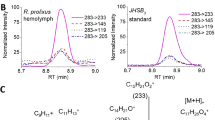Abstract
THE endocrine changes that initiate the metamorphosis of insect caterpillars into pupae and, ultimately, into adult moths occur over a very short time period. Thus, it is not surprising that titres of the hormones that control this process seem to be regulated by changes in the rates of both biosynthesis and degradation. A reduction in the titre of juvenile hormone (JH) early in the last larval instar has been shown to initiate metamorphosis and lead to a cessation of feeding behaviour1 This reduction in JH is associated with a dramatic increase in the levels of a very active, specific enzyme that hydrolyses the chemically stable, conjugated methyl ester to the biologically inactive JH acid2. If this juvenile hormone esterase (JHE) is inhibited, the in vivo JH titre remains high enough to keep the larva in the feeding stage, resulting in giant insects3. Thus, if sufficient quantities of JHE were expressed in vivo at an early stage of development, the reduction in JH titre should cause the affected insect to stop feeding. Because of its low abundance, the purification of sufficient JHE from the blood of caterpillars was very difficult until the development of a highly efficient affinity purification system4. This system produced enough JHE for the development of antibodies and for partial amino-acid sequencing of JHE from several species including the major insect pest, Heliothis virescens5,6. Three similar clones thought to encode JHE were obtained from a complementary DNA library made from fat bodies of H. virescens7. Here, we describe the expression of JHE in an in vitro baculovirus system which will provide enough enzyme for detailed biochemical and physiological studies. The results suggest that in vivo expression of JHE may help in the improvement of genetically engineered viral insecticides which work by reducing insect feeding.
This is a preview of subscription content, access via your institution
Access options
Subscribe to this journal
Receive 51 print issues and online access
$199.00 per year
only $3.90 per issue
Buy this article
- Purchase on Springer Link
- Instant access to full article PDF
Prices may be subject to local taxes which are calculated during checkout
Similar content being viewed by others
References
deKort, C. A. D., Granger, N. A. A. Rev. Entomol. 26, 1–28 (1981).
Hammock, B. D. in Comparative Insect Physiology Biochemistry and Pharmacology, 431–472, Vol. 7 (Pergamon Press, New York, 1985).
Sparks, T. C. & Hammock, B. D. Pestic. Biochem. Physiol. 14, 290–302 (1980).
Abdel-Aal, Y. A. I. and Hammock, B. D. Science 233, 1073–1076 (1986).
Hanzlik, T. N. et al. J. biol. Chem. 262, 13584–13591 (1987).
Hammock, B. D. et al. in Biomechanisms Regulating Growth and Development Vol. 12, 137–173 (Kluwer Academic Publishers, Dordrecht, 1988).
Hanzlik, T. N. & Hammock, B. D. J. biol. Chem. 264, 12419–12425 (1989).
Summers, M. D. & Smith, G. E. Texas Agric. Exp. Station Bull. 1555, 1–56 (1987).
Luckow, V. A. & Summers, M. D. Biotechnology, 6, 47–55.
Miller, L. K. A. Rev. Microbiol. 42, 177–199 (1988).
Maeda, S. A. Rev. Entomol. 34, 351–372 (1989).
Bishop, D. H. L. & Possee, R. D. Adv. Gene Technol. (in press).
Matsuura, Y. et al. J. gen. Virol. 68, 1233–1250 (1987).
Possee, R. D. & Howard, S. C. Nucleic Acids Res. 15, 10233–10248 (1987).
Vaughn, J. L. et al. In Vitro 13, 213–217 (1977).
Hammock, B. D. & Sparks, T. C. Analyt. Biochem. 82, 573–579 (1977).
O'Shannessy, D. J., Voorstad, P. J. & Quarles, R. H. Analyt. Biochem. 163, 204–209 (1987).
Masner, P. et al. Pestic. Sci. 18, 89–94 (1987).
Truman, J. W., Riddiford, L. M. & Safranek, L. J. Insect Physiol. 21, 1931–1938 (1973).
Staal, G. B. A. Rev. Entomol. 31, 391–429 (1986).
Philpott, M. L. & Hammock, B. D. Insect Biochem. (in press).
Hanzlik, T. N. & Hammock, B. D. Arch. Insect Biochem. Physiol. 9, 135–156 (1988).
Cordonnier, A., Montagnier, L. & Emerman, M. Nature 340, 571–574 (1989).
Benz, G. A. in The Biology of Baculoviruses, 1–33 (CRC Press, Boca Raton, 1986).
O'Reilly, D. R. & Miller, L. K. Science 245, 1110–1112 (1989).
Author information
Authors and Affiliations
Rights and permissions
About this article
Cite this article
Hammock, B., Bonning, B., Possee, R. et al. Expression and effects of the juvenile hormone esterase in a baculovirus vector. Nature 344, 458–461 (1990). https://doi.org/10.1038/344458a0
Received:
Accepted:
Issue Date:
DOI: https://doi.org/10.1038/344458a0
This article is cited by
-
Insecticidal activity of two proteases against Spodoptera frugiperda larvae infected with recombinant baculoviruses
Virology Journal (2010)
-
Baculovirus-mediated expression of a Chinese scorpion neurotoxin improves insecticidal efficacy
Science Bulletin (2008)
-
The use of a recombinant baculovirus expressing a chitinase from the hard tick Haemaphysalis longicornis and its potential application as a bioacaricide for tick control
Parasitology Research (2006)
Comments
By submitting a comment you agree to abide by our Terms and Community Guidelines. If you find something abusive or that does not comply with our terms or guidelines please flag it as inappropriate.



